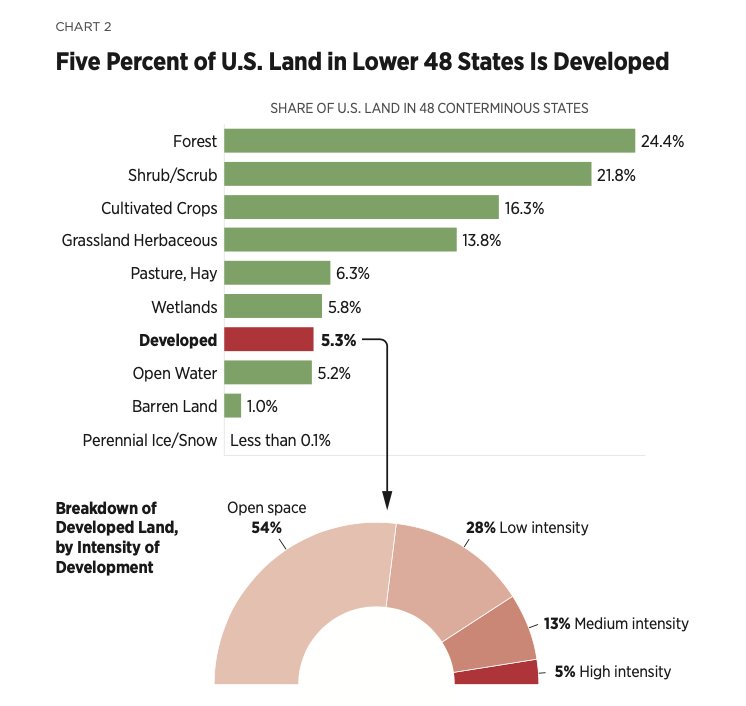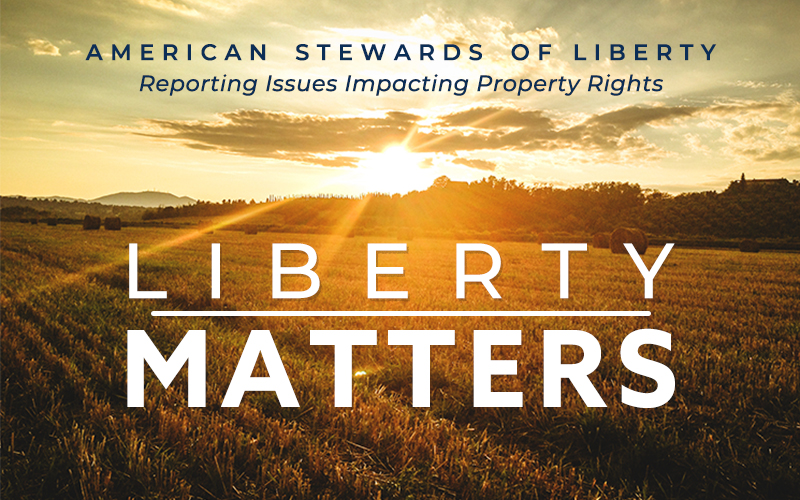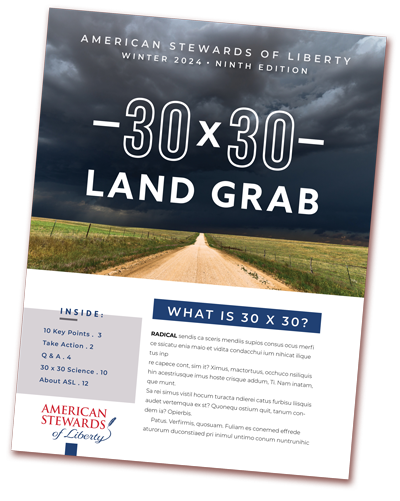The Heritage Foundation has released a new report authored by Rob Gordon, a seasoned conservation and natural resource expert that answers the question of whether America’s lands, habitat, and wildlife are declining as proponents of the 30×30 agenda claim. The report is titled, “Lands and Habitat in the United States: A Reality Check.”
Using actual land use trends and wildlife populations as an indicator of habitat availability, the report finds the 30×30 advocates and the Biden Administration’s claims are unfounded.
“Contrary to the familiar, agenda-driven narrative, development or conversion of natural landscapes to agricultural and urban use in the United States is not rapidly growing, nor are all U.S. species generally becoming ever more endangered. Left unchallenged, misinformation regarding the environment provides undue support for those who wish to impose wrong-headed, economically harmful polices upon an already enormous government estate, to enlarge it even further, and to impose economically destructive and burdensome regimes on those private lands that escape. Americans should be generally optimistic about the state of our lands and wildlife.” (Page 1)
The comprehensive examination of land use and habitat trends in America debunk several myths advanced by the environmental community to push the international 30×30 agenda on the American people. A few of worth noting are as follows:
30×30 Myth # 1: “We are losing a football field of habitat every 30 seconds.”
During 2001 and 2016, the data shows that there has been no land cover change for 92% of America’s land. Most of the land cover change of the remaining 7.6% of land was on forested lands due largely to harvest, fire, disease and pests.
Only 5.3 percent of America’s land is considered developed. Over half of this is considered open space, which include large lots, parks, golf courses, and vegetation plantings for erosion.
“In the decade-and-a-half between 2001 and 2016, all developed land classes combined increased as a percentage of the conterminous 48 states by just 0.3 percent. At this rate, it would take another four decades for developed areas to encompass about another 1 percent of the conterminous United States. While some of these acres may be ‘lost’ from the Biden Administration’s perspective, for others these lands now have neighborhoods, schools, grocery stores, churches, or places of work.” (Page 9)
“Even if the Administration’s figure of a football field “lost” every 30 seconds is true, at that rate it would take over eight centuries to ‘lose’ it all (not including Alaska and Hawaii). The United States would have to more than double the land in agricultural covers—while it has been declining—or increase the land developed since colonial times more than ten-fold. There is absolutely nothing that supports such a projection. Using this figure without context to scare people, including youth, is misleading and cruel.” (Page 22)
30×30 Myth # 2: “Our food systems are currently the single biggest underlying source of decline in nature, responsible for three-quarters of deforestation.”
During the 2001-2016 period, the acres in agriculture use saw little change. In 2001, there were an estimated 449 million acres in production and by 2016, that figure ticked up only slightly to 450 million.
“American farmers have been able to feed a population that more than tripled to over 330 million and export $150 billion worth of agricultural products in 2020 without converting more forest land. In fact, over the past 75 years, while using less land, farmers almost tripled farm output, and by 2019, Americans spent a historically low percentage of their disposable income on total food.” (Page 11)
Not only has American agriculture productivity led to less deforestation, it also converts more carbon dioxide to oxygen than any other place on earth.
“NASA scientists found that during the Northern Hemisphere’s growing season, the Midwest region of the United States boasts more photosynthetic activity than any other spot on earth. In fact, data showed that fluorescence from the Corn Belt, which extends from Ohio to Nebraska and Kansas, peaks in July at levels 40 percent greater than those observed in the Amazon, which is often referred to as “the lungs of the Earth.” (Page 11)
30×30 Myth # 3: “If we do not permanently protect 30% of our lands and oceans by 2030, over 1/3 of America’s species will go extinct in the coming decades.”
Species in America are not in peril. In fact, key species that have substantial habitat requirements have been expanding outside of their historical areas as the population has moved from one that largely hunted and farmed in pre-colonial days, to a population that now largely resides in cities and relies on the more efficient agriculture industry.
“The improvements attest to the basic requirements of suitable habitat and, for predators, sufficient prey. Some species—such as the red fox, javelina, armadillo, and opossum—have continued range expansions that began long ago, while still others—such as the coyote, raccoon, and snow goose—have proven highly adaptable to the altered landscape and are expanding. Additionally, many of these species are considered game species (for example, almost all the ungulates and waterfowl) and are therefore subject to the additional population pressure of hunting and/or trapping, yet many have exhibited growing populations. And the numbers are dramatic, with elk, pronghorn, white-tailed and mule deer, musk oxen, black bears, bobcats, red foxes, otters, beavers, northern elephant and gray seals, wild turkeys, red-tailed hawks, merlins, wood ducks, sandhill cranes, trumpeter swans, and many other species increasing substantially—doubling, tripling, or even more. Many of these species were depleted to mere thousands and now number in the hundreds of thousands, a million, or more.” (Page 19)
The expansion of these key species habitat is an indicator that other, less charismatic species habitat is also expanding, contrary to the environmentalist’s claim. Notably, the species federally protected under the Endangered Species Act are largely “sub-species,” or “distinct population segments,” classifications that are subjective and controversial within the scientific community.
“About 70 percent of listed U.S. mammals are subspecies or distinct population segments. As Appendix 3 indicates, the population estimates for many full species, a more objectively defined and therefore relative to subspecies, more reliable taxonomic unit, are generally secure.” (Page 21)
30×30 Myth #4: “Only 12 percent of the land in the United States is protected.”
This figure is generated from the USGS PAD-US Gap Analysis Project (GAP), where lands in the United States are categorized into 4 levels, based on the level of regulatory protection. The highest level, GAP 1, allows for no more that 5 percent of the land to be in an “unnatural state,” or containing human impacts. The second key metric used may have more human activity, but has regulatory assurances that the lands are permanently protected from development. GAP 1 & 2 combined total 12 percent, the amount of land the Biden Administration considered protected.
However, government owns an enormous amount of land in America – 36 percent when you combine federal, state, regional and local government holdings. Those not already in the 12 percent figure are largely Gap 3 lands. Additionally, the American Indian lands are substantial, and the known NGO-held conservation easements total an area larger than Maryland and Vermont combined.
Add into this figure the vast areas regulated under endangered species critical habitat (110 million – 250 million acres), Wild and Scenic Rivers, Wetland’s restrictions, international land designations, and other restrictions, and it is clear the Administrative state already regulates a substantial amount of America’s lands.
The Gap 4 lands are largely the private lands, and are categorized as unprotected because the regulators and environmentalists do not know the “management intent.”
“This massive acreage where the “management intent” is largely unknown to the federal government includes farms, ranches, privately owned woodlands, and most other private property as well as American Indian lands—the 64.5 percent of the country not owned by federal, state, or local government. Undoubtedly, ‘more effort and investment from decision-makers’ would be needed to either acquire a substantial portion of this land or establish permanent ‘biodiversity protections as priorities’ upon it. As the Defenders of Wildlife sees it, ‘private lands lacking formal conservation designations are critically important to addressing biodiversity and climate goals.’” (Page 25)
“The consequences of the federal government consuming another 18 percent of the nation are hard to even contemplate, as are new or increased requirements for property owners to have land management papers explaining their “management intent” so the federal government may track it. Expanding the regulatory authorities over private lands or the portfolios of land management agencies that the Congressional Research Service reports already have a $19.38 billion maintenance backlog would seem a factor to consider as well.” (Page 28)
It’s Not About Conservation
If 30×30 is about “conserving” the lands, as the Biden Administration claims, then there is definitive evidence that this bar has already been met. However, the Biden Administration continues to paint a dire and failing state of our lands, species, and biodiversity, despite the evidence to the contrary. This leads us to the obvious conclusion: 30×30 is about controlling the lands they do not yet possess and removing the last productive uses of those lands they already own.
*****
The author of this report, Rob Gordon, may be making a special appearance at the “Stop 30×30 Summit.” Watch for more details.
Robert Gordon is a Senior Research Fellow in Regulatory Policy in Heritage’s Center for Free Markets and Regulatory Reform.






